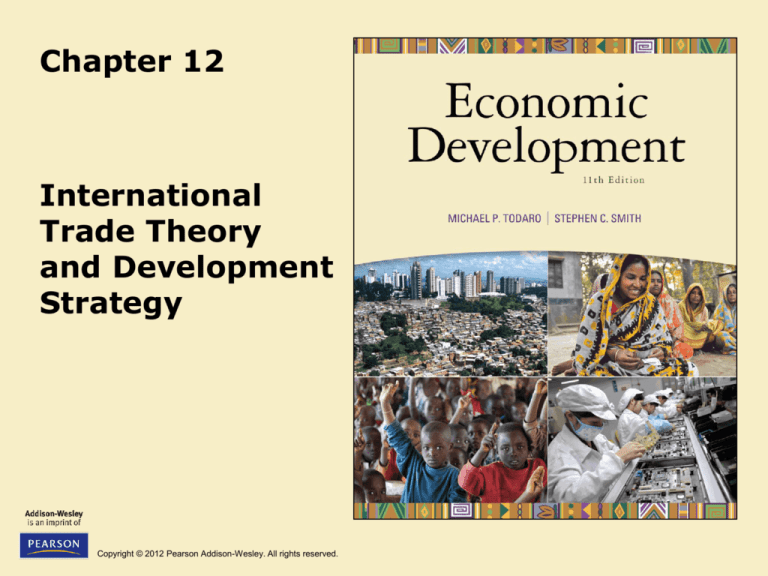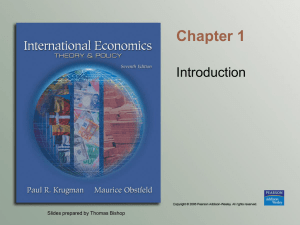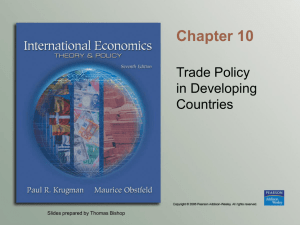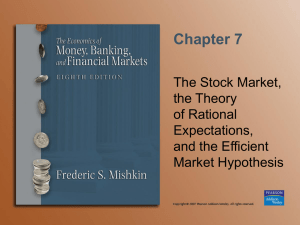
Chapter 12
International
Trade Theory
and Development
Strategy
Copyright © 2012 Pearson Addison-Wesley. All rights reserved.
12.1 Economic Globalization: An
Introduction
• Globalization- many interpretations
• Core economic meaning- the increased
openness of economies to international
trade, financial flows, and foreign direct
investment
• Concerns with globalization center around
the unevenness of the process, and risks
Copyright © 2012 Pearson Addison-Wesley. All rights reserved.
12-2
12.2 International Trade: Some Key
Issues
• Many developing countries rely heavily on exports of
primary products with attendant risks and uncertainty
• Many developing countries also rely heavily on imports
(typically of machinery, capital goods, intermediate
producer goods, and consumer products)
• Many developing countries have chronic deficits on current
and capital accounts which depletes their reserves, causes
currency instability, and may slow economic growth
• Recently many developing countries sought to promote
exports and accumulate large foreign exchange reserves to
cushion against crises - spurring new policy debates
Copyright © 2012 Pearson Addison-Wesley. All rights reserved.
12-3
12.2 International Trade: Some Key
Issues
• Five Basic Questions about Trade and
Development
– How does international trade affect economic
growth?
– How does trade alter the distribution of
income?
– How can trade promote development?
– Can developing countries determine how much
they trade?
– Is an outward-looking or an inward-looking
trade policy best?
Copyright © 2012 Pearson Addison-Wesley. All rights reserved.
12-4
12.2 International Trade: Some Key
Issues
• The Importance of Exports to Different
Developing Nations
• Importance of exports to developing nations
• Exports of developing countries are generally less
diversified than those of developed countries
• Merchandise exports as a share of GDP are often
higher for developing countries
Copyright © 2012 Pearson Addison-Wesley. All rights reserved.
12-5
Table 12.1 Merchandise Exports in Perspective:
Selected Countries, 2008
Copyright © 2012 Pearson Addison-Wesley. All rights reserved.
12-6
Demand Elasticities and Export Earning
Instability
• Often low price elasticity of demand for
agricultural commodities but supply shocks
• Often low price elasticity of supply for
basic commodities but demand shocks
• Result can be export earnings instability;
risks to income
• Also, low income elasticity of demand for
primary products:
Copyright © 2012 Pearson Addison-Wesley. All rights reserved.
12-7
The Terms of Trade and the PrebischSinger Hypothesis
• Total export earnings depend upon:
– Total volume of exports sold; and,
– Price paid for exports
• Prebisch and Singer argued commodity export prices fall
over time, so developing countries lose revenue unless
they can continually increase export volumes
• They concluded that developing countries need to avoid
dependence on primary exports
• Some evidence relative prices within manufactures are
also diverging with falling prices for low-skill products
Copyright © 2012 Pearson Addison-Wesley. All rights reserved.
12-8
12.3 The Traditional Theory of
International Trade
• Comparative advantage
– specialization
• Relative factor endowments and
international specialization: the
Neoclassical model
– Ricardo and Mill (static model)
– Heckscher and Ohlin (factor endowment
theory)
• Different products require productive factors in
different ratios
• Countries have different endowments of factors of
production
Copyright © 2012 Pearson Addison-Wesley. All rights reserved.
12-9
Figure 12.1 Trade with Variable Factor Proportions
and Different Factor Endowments
Copyright © 2012 Pearson Addison-Wesley. All rights reserved.
12-10
Figure 12.1 Trade with Variable Factor Proportions
and Different Factor Endowments (continued)
Copyright © 2012 Pearson Addison-Wesley. All rights reserved.
12-11
12.3 The Traditional Theory of
International Trade (cont’d)
• Main conclusion of the neoclassical model is that
all countries gain from trade
• World output increases with trade
• Countries will tend to specialize in products that
use their abundant resources intensively
• International wage rates and capital costs will
gradually tend toward equalization
• Returns to owners of abundant resources will rise
relatively
• Trade will stimulate economic growth
Copyright © 2012 Pearson Addison-Wesley. All rights reserved.
12-12
12.3 The Traditional Theory of
International Trade (cont’d)
• Trade theory and Development: The Traditional
Arguments
– Trade stimulates economic growth
– Trade promotes international and domestic equality
– Trade promotes and rewards sectors of comparative
advantage
– International prices and costs of production determine
trading volumes
– Outward-looking international policy is superior to
isolation
Copyright © 2012 Pearson Addison-Wesley. All rights reserved.
12-13
12.4 Critique of Traditional Free-Trade Theory,
in the Context of Developing-Country
Experience
• The following assumptions of the basic
Neoclassical model have been scrutinized:
– Fixed resources, full employment, international factor
immobility
– And fixed, freely available technology and consumer sovereignty
vs product cycle, ongoing development of synthetic substitutes
for developing countries exports, and opportunities for dynamic
gains in leading sectors
– Internal factor mobility vs different types of structural rigidities;
and perfect competition vs pervasive market power
– Governmental non-interference in trade vs active trade policies
– Balanced trade and international price adjustments vs instability
– Trade gains accruing to nationals vs export enclaves with
foreign ownership; distinction between GDP and GNI becomes
important
Copyright © 2012 Pearson Addison-Wesley. All rights reserved.
12-14
12.4 The Critique of Traditional Free-Trade
Theory in the Context of Developing-Country
Experience
• Fixed Resources, Full Employment, and the
International Immobility of Capital and Skilled Labor
– Challenged by North-South trade models
• Porter’s “Competitive Advantage” theory:
– Traditional trade theory applies only to basic factors
(unskilled labor, physical resources)
– But creation of advanced factors (knowledge resources,
specialized infrastructure) is the first priority
– Central task to “escape from the straightjacket of factordriven national advantage”
Copyright © 2012 Pearson Addison-Wesley. All rights reserved.
12-15
12.4 The Critique of Traditional Free-Trade
Theory in the Context of Developing-Country
Experience
• Alternative Theories
• Vent for Surplus theory
Copyright © 2012 Pearson Addison-Wesley. All rights reserved.
12-16
Figure 12.2 The Vent-for-Surplus Theory of
Trade
Copyright © 2012 Pearson Addison-Wesley. All rights reserved.
12-17
12.4 The Critique of Traditional Free-Trade
Theory in the Context of Developing-Country
Experience (cont’d)
• Fixed, Freely Available Technology and
Consumer Sovereignty
– Challenged by the Product Cycle theory
– Development of synthetic substitutes for
developing country exports
Copyright © 2012 Pearson Addison-Wesley. All rights reserved.
12-18
12.4 The Critique of Traditional Free-Trade
Theory in the Context of Developing-Country
Experience (cont’d)
• International Factor Mobility, Perfect Competition,
and Uncertainty: Increasing Returns, Imperfect
Competition, and Issues in Specialization
– Structural realities in developing countries
– Increasing returns and exercise of monopolistic control
over world markets
– Risk and uncertainty inherent in international trading
arrangements
Copyright © 2012 Pearson Addison-Wesley. All rights reserved.
12-19
12.4 The Critique of Traditional Free-Trade
Theory in the Context of Developing-Country
Experience (cont’d)
• The Absence of National Governments in
Trading Relations
– Definite role for State
– Industrial policy is crafted by governments
– Commercial policies instruments (tariffs,
quotas) are state constructs
– International policies can result in uneven
distribution of gains from trade
Copyright © 2012 Pearson Addison-Wesley. All rights reserved.
12-20
12.4 The Critique of Traditional Free-Trade
Theory in the Context of Developing-Country
Experience (cont’d)
• Balanced Trade and International Price
Adjustments
– Unrealistic (example: impact of oil price hikes
of the 1970s)
Copyright © 2012 Pearson Addison-Wesley. All rights reserved.
12-21
12.4 The Critique of Traditional Free-Trade
Theory in the Context of Developing-Country
Experience (cont’d)
• Trade gains accruing to nationals
– Enclave economies are promoted by trade
– Difference between GDP and GNI becomes
important
Copyright © 2012 Pearson Addison-Wesley. All rights reserved.
12-22
12.4 The Critique of Traditional Free-Trade
Theory in the Context of Developing-Country
Experience (cont’d)
• Some Conclusions on Trade Theory and
Economic Development Strategy
– Trade can lead to rapid economic growth under
some circumstances
– Trade seems to reinforce existing income
inequalities
– Trade can benefit developing countries if they
can extract trade concessions from developed
countries
– Developing countries generally must trade
– Regional cooperation may help developing
countries
Copyright © 2012 Pearson Addison-Wesley. All rights reserved.
12-23
12.5 Traditional Trade Strategies for
Development: Export Promotion versus Import
Substitution
• Export promotion: looking outward and seeing trade
barriers
– Primary-commodity export expansion, limited demand
• Low income elasticities
• Low population growth rates in developing economies
• Decline in prices implies low revenue (some periods of price spikes,
including recent years, but very long-run trend has been
downward)
• Lack of success with international commodity agreements
• Development of synthetic substitutes
• Agricultural subsidies
– Primary-commodity export expansion, supply rigidities
• Expanding Exports of manufactured goods: Greater
successes, particularly China; unevenly distributed across
the developing world
Copyright © 2012 Pearson Addison-Wesley. All rights reserved.
12-24
12.5 Traditional Trade Strategies for
Development: Export Promotion versus Import
Substitution
• Import substitution: looking inward but
still paying outward
– Tariffs, infant industries, and the theory of
protection
Copyright © 2012 Pearson Addison-Wesley. All rights reserved.
12-25
12-25
Figure 12.3
Import
Substitution and
the Theory of
Protection
Copyright © 2012 Pearson Addison-Wesley. All rights reserved.
12-26
12.5 Traditional Trade Strategies for
Development: Export Promotion versus Import
Substitution (cont’d)
• The import substitution (IS)
industrialization strategy and results
– Protected industries get inefficient and costly
– Foreign firms often benefit more
– Subsidization of imports of capital goods tilts
pattern of industrialization and contributes to
balance of payments (BOP) problems
– Overvalued exchange rates hurt exports
– Does not stimulate self-reliant integrated
industrialization
Copyright © 2012 Pearson Addison-Wesley. All rights reserved.
12-27
12.5 Traditional Trade Strategies for
Development: Export Promotion versus Import
Substitution (cont’d)
• Tariff Structure and Effective Protection
– Nominal rate of protection
– Effective rate of protection
Copyright © 2012 Pearson Addison-Wesley. All rights reserved.
12-28
12.5 Traditional Trade Strategies for
Development: Export Promotion versus Import
Substitution (cont’d)
The nominal tariff rate, t, is
p p
t
p
(12.1)
Where
p′ is the tariff-inclusive price
p is the free trade price
Copyright © 2012 Pearson Addison-Wesley. All rights reserved.
12-29
12.5 Traditional Trade Strategies for
Development: Export Promotion versus Import
Substitution (cont’d)
Tariff Structures and Effective Protection
The effective tariff rate, g, is
v v
v
(12.2)
Where
v′ is the value added per unit of output,
inclusive of the tariff
v is the value added per unit of output
under free trade
Copyright © 2012 Pearson Addison-Wesley. All rights reserved.
12-30
12.5 Traditional Trade Strategies for
Development: Export Promotion versus Import
Substitution (cont’d)
• Standard argument for tariff protection
–
–
–
–
Sources of revenue
Response to chronic BOP problems
Help foster industrial self-reliance (general IS)
Greater control over economic destinies
• Must be applied selectively and wisely
• Infant industry protection argument
– Many examples of perceived failures, but some success
in East Asia
Copyright © 2012 Pearson Addison-Wesley. All rights reserved.
12-31
12.5 Traditional Trade Strategies for
Development: Export Promotion versus Import
Substitution
• Foreign-exchange rates, exchange
controls, and the devaluation decision
– Developing country currencies have often been
overvalued (excess of local demand over available
exchange)
– A developing country can devalue currency, or
– Can run down reserves
– Can curtail excess demand through taxes, tariffs, dual
exchange rates
– Can use exchange controls
– Can switch to freely convertible foreign exchange
Copyright © 2012 Pearson Addison-Wesley. All rights reserved.
12-32
Figure 12.4 Free-Market and Controlled Rates of
Foreign Exchange
Copyright © 2012 Pearson Addison-Wesley. All rights reserved.
12-33
12.5 Traditional Trade Strategies for
Development: Export Promotion versus Import
Substitution (cont’d)
• Chronic payments deficits can be
ameliorated by a currency devaluation
– Difference between depreciation and
devaluation
– Higher import prices result in an inflationary
wage-price spiral
– Distributional effects
Copyright © 2012 Pearson Addison-Wesley. All rights reserved.
12-34
12.5 Traditional Trade Strategies for
Development: Export Promotion versus Import
Substitution (cont’d)
• Trade Optimists and Trade Pessimists:
Summarizing the Traditional Debate
• Trade pessimist arguments
– Limited growth of world demand for primary exports
– Secular deterioration in terms of trade
– Specializing in comparative advantage inhibits
industrialization, skills accumulation, and
entrepreneurship
– Rise of “new protectionism”; WTO benefits limited in
practice
Copyright © 2012 Pearson Addison-Wesley. All rights reserved.
12-35
12.5 Traditional Trade Strategies for
Development: Export Promotion versus Import
Substitution (cont’d)
• Trade optimist arguments - trade liberalization:
– Promotes competition and efficiency
– Generates pressure for product improvement
– Accelerates overall growth
– Attracts foreign capital and expertise, which are in scarce
supply in most developing countries
– Generates foreign exchange to use for food imports if
agricultural sector lags behind or suffers natural
catastrophes
– Eliminates distortions caused by government
interventions including corruption and rent-seeking
activities
– Promotes equal access to scarce resources,
– Enables developing countries to take full advantage of
reforms under the WTO
Copyright © 2012 Pearson Addison-Wesley. All rights reserved.
12-36
Export-Oriented Industrialization Strategy: Some
arguments in the literature on why, in principle, it
could be effective:
• There are market failures in transfer of innovations
• Coordination failures may make industrialization problematic
• Export expansion may facilitate technology transfer through
contacts with foreign firms, industry spillovers, scale economies
• There may be learning by doing (or “watching”) effects in
manufacturing sectors
• Performance is rigorously tested when firms attempt to export
• Export targets more visible; focus on manageable problems
• Hausmann, Hwang, and Rodrik: exporting a mix of goods more
typical for higher-income countries predicts higher growth
• Thus, export oriented industrial policy may help overcome
market failures in the process of technological progress
Copyright © 2012 Pearson Addison-Wesley. All rights reserved.
12-37
12.6 The Industrialization Strategy
Approach to Export Policy
– Focus on government interventions to encourage
exports, especially those with higher skill and
technology content (industrial policy)
– Problem: without proper attention to incentives,
industrial policies may be counterproductive too
– WTO rules and industrial policies – gray areas remain
– Problem: level of competence and political authority of
governments to carry out policies effectively
– Policy approaches are addressed in case studies of
Taiwan (Chapter 12) and South Korea (Chapter 13)
Copyright © 2012 Pearson Addison-Wesley. All rights reserved.
12-38
12.7 South-South Trade and Economic
Integration
• Economic Integration: Theory and Practice
– The growth of trade among developing
countries.
– Integration encourages rational division of
labor among a group of countries and increases
market size
– Provides opportunities for a coordinated
industrial strategy to exploit economies of scale
– Trade creation
– Trade diversion
Copyright © 2012 Pearson Addison-Wesley. All rights reserved.
12-39
12.7 South-South Trade and Economic
Integration
• Regional trading blocs and the globalization of
trade
–
–
–
–
–
–
NAFTA
MERCOSUR
SADC
ASEAN
Local conditions matter
Still not fully answered: Do blocs promote growth or
retard the progress of globalization
Copyright © 2012 Pearson Addison-Wesley. All rights reserved.
12-40
12.8 Trade Policies of Developed Countries: The Need for
Reform and Resistance to New Protectionist Pressures
• Rich-nation economic and commercial policies matter for
developing countries
– Tariff and non-tariff barriers to developing country exports
– Adjustment assistance for displaced workers
– General impact of economic policy
• World Trade Organization
• Despite 8 liberalization rounds over 50 years, trade barriers
remain in place in agriculture; and, through various
mechanisms, to a degree in other sectors
• Doha Development Round begun 2001 tilted the nominal
focus to needs of developing world; but talks remained
stalled through the end of 2010, a self-imposed deadline
Copyright © 2012 Pearson Addison-Wesley. All rights reserved.
12-41
Figure 12.5 Effective Tariff Faced by Income
Groups, 1997-1998
Copyright © 2012 Pearson Addison-Wesley. All rights reserved.
12-42
Concepts for Review
•
•
•
•
•
•
•
Absolute advantage
Autarky
Balanced trade
Barter transactions
Capital account
Commodity terms of trade
Common Market
Copyright © 2012 Pearson Addison-Wesley. All rights reserved.
•
•
•
•
•
•
•
•
Comparative advantage
Current account
Customs Union
Depreciation
Devaluation
Dual exchange rate
Economic Integration
Economic Unions
12-43
Concepts for Review (cont’d)
•
•
•
•
•
•
Effective Rate of Protection
Enclave economies
Exchange Control
Export dependence
Export earnings instability
Factor endowment trade
theory
Copyright © 2012 Pearson Addison-Wesley. All rights reserved.
•
•
•
•
•
•
Factor price equalization
Flexible exchange rate
Foreign-exchange earnings
Free market exchange rate
Free trade
Free trade area
12-44
Concepts for Review (cont’d)
• Gains from trade
• General Agreement on
Tariffs and Trade (GATT
Globalization
• Globalization
• Growth poles
• Import substitution
• Income elasticity of
demand
Copyright © 2012 Pearson Addison-Wesley. All rights reserved.
• Increasing returns
• Industrialization Strategy
Approach
• Industrial policy
• Infant industry
• International commodity
agreements
• Inward-looking
development policies
12-45
Concepts for Review (cont’d)
• Managed float
• Monopolistic market control
• Multifiber Arrangement
(MFA)
• New protectionism
• Nominal rate of protection
• Nontariff trade barriers
• North-South trade models
Copyright © 2012 Pearson Addison-Wesley. All rights reserved.
• Official exchange rate
• Oligopolistic market control
• Outward-looking
development policies
• Overvalued exchange rate
• Parallel exchange rate
• Prebisch-Singer thesis
12-46
Concepts for Review (cont’d)
•
•
•
•
•
•
•
Price elasticity of demand
Primary products
Product Cycle
Product differentiation
Quotas
Regional trading bloc
Rent
Copyright © 2012 Pearson Addison-Wesley. All rights reserved.
•
•
•
•
•
•
•
•
Returns to scale
Risk
Specialization
Subsidy
Synthetic substitutes
Tariffs
Trade creation
Trade deficits
12-47
Concepts for Review (cont’d)
•
•
•
•
•
•
•
•
Trade diversion
Trade liberalization
Trade optimists
Trade pessimists
Uncertainty
Undervalued exchange rate
Uruguay Round
Value added
Copyright © 2012 Pearson Addison-Wesley. All rights reserved.
• Vent-for-surplus theory of
international trade
• Wage-price spiral
• World Trade Organization
(WTO)
12-48








